SVIF Seminar "Differences to Make a Successful Venture": 「成功できるベンチャーは何が違うのか」 [Report]
SVIF Seminar: Mitch Kitamura "Differences to Make Successful Venture"
北村充崇「成功できるベンチャーは何が違うのか~我々ができること」(2016年5月13日)
Title タイトル: "Differences to Make a Successful Venture -- What to Do";
「成功できるベンチャーは何が違うのか~我々ができること」
Speaker スピーカー: Mitch Kitamura; 北村充崇 (Managing Director, DraperNexus)
Date/Time 日時: May 13(F), 2016, 7:30-9:00pm; 5月13日(金)19:30~21:00
Venue 場所: Wilson Sonsini Goodrich & Rosati, 650 Page Mill Road, Palo Alto, CA
Website ウェブサイト: http://www.svinnovationforum.org/event_in_sv
Mr. Kitamura's Presentation at SVIF Seminar; SVIFセミナーでの北村充崇氏のプレゼン
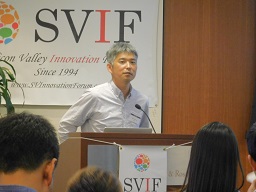
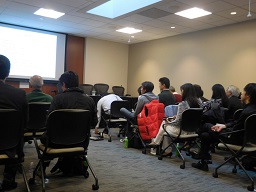
Report:
Based on his venture capitalist career for two decades, Mitch Kitamura (Managing Director of DraperNexus Ventures) made quite an impressive and informative presentation about recent trends in venture business in Silicon Valley at his SVIF seminar for mostly Japanese business audience in Northern California.
After identifying four target areas for current venture business, namely, big data-based insurance, autonomous vehicles, cyber security, and blockchain, he listed key factors which seem to differentiate successful ventures from unsuccessful ones -- (1) grit (or resolve), (2) persuasive story, and (3) fast growth.
On the other hand, the single most important reason for failure appears to be "no market lead", that is, no market demand for the new product developed by venture business, according to Mr. Kitamura.
However, there were quite a few questions about this statement from the audience, pointing out that at least some of the successful venture businesses made a success, exactly because there were no markets for their products until they produced and marketed -- so the question is how to resolve this dilemma for venture business.
Apparently no clear answer exists, but what Mr. Kitamura called the Silicon Valley Rules could give a good suggestion as to how to deal with this dilemma for future success in venture business: that is, (1) pay it forward: give and take, (2) do and build a thing, (3) open to feedback, and (4) be excited with what you do -- very good advice indeed.
(Reported by T. Miyao)
報告:
20年に渡るベンチャーキャピタリストの経験に基づき、北村氏は主に北カリフォルニア地域の日本人のビジネス関係者を対象とするSVIF講演会で、シリコンバレーでのベンチャービジネスの最近のトレンドについて非常に印象深く極めて有益な内容のプレゼンを行った。
まず、最近のベンチャービジネスがターゲットとしている4つの分野、つまりビッグデータによる保険サービス、自動運転の乗り物、サイバーセキュリティー、およびブロックチェインを挙げた後に、成功できるベンチャーをそうでないものから分ける重要な要因をリストした。
それらは、(1)やり抜く力、ないし気概、(2)説得力あるストーリー、および(3)急成長力。
これに対して北村氏によると、失敗する最大の要因は、市場が存在しなかった、つまり新製品を開発しても誰も買わなかったことであるという。
しかしながら、この点については参加者から色々な関連質問が出て、これまで成功したベンチャービジネスのいくつかは、まさにその商品が生み出されて売りに出されるまでは市場がなかったケースがあることが指摘されたーーこの点をどうするかはベンチャービジネスの真のジレンマと言えるのかもしれない。
それについての明確な答えはないが、北村氏が最後に触れた「シリコンバレーの掟」が、このジレンマを乗り越えて将来の成功を導くための示唆を与えているようにみえる。それらは、(1)まず自分が与えてから何かを得る、(2)やってみる、モノを作ってみる、(3)他人の意見に耳を傾ける、そして(4)自分のやることに情熱を注ぐーー実に良いアドバイスである。
(宮尾)
-------------------------------------------------------------------------------------------
北村充崇「成功できるベンチャーは何が違うのか~我々ができること」(2016年5月13日)
Title タイトル: "Differences to Make a Successful Venture -- What to Do";
「成功できるベンチャーは何が違うのか~我々ができること」
Speaker スピーカー: Mitch Kitamura; 北村充崇 (Managing Director, DraperNexus)
Date/Time 日時: May 13(F), 2016, 7:30-9:00pm; 5月13日(金)19:30~21:00
Venue 場所: Wilson Sonsini Goodrich & Rosati, 650 Page Mill Road, Palo Alto, CA
Website ウェブサイト: http://www.svinnovationforum.org/event_in_sv
Mr. Kitamura's Presentation at SVIF Seminar; SVIFセミナーでの北村充崇氏のプレゼン


Report:
Based on his venture capitalist career for two decades, Mitch Kitamura (Managing Director of DraperNexus Ventures) made quite an impressive and informative presentation about recent trends in venture business in Silicon Valley at his SVIF seminar for mostly Japanese business audience in Northern California.
After identifying four target areas for current venture business, namely, big data-based insurance, autonomous vehicles, cyber security, and blockchain, he listed key factors which seem to differentiate successful ventures from unsuccessful ones -- (1) grit (or resolve), (2) persuasive story, and (3) fast growth.
On the other hand, the single most important reason for failure appears to be "no market lead", that is, no market demand for the new product developed by venture business, according to Mr. Kitamura.
However, there were quite a few questions about this statement from the audience, pointing out that at least some of the successful venture businesses made a success, exactly because there were no markets for their products until they produced and marketed -- so the question is how to resolve this dilemma for venture business.
Apparently no clear answer exists, but what Mr. Kitamura called the Silicon Valley Rules could give a good suggestion as to how to deal with this dilemma for future success in venture business: that is, (1) pay it forward: give and take, (2) do and build a thing, (3) open to feedback, and (4) be excited with what you do -- very good advice indeed.
(Reported by T. Miyao)
報告:
20年に渡るベンチャーキャピタリストの経験に基づき、北村氏は主に北カリフォルニア地域の日本人のビジネス関係者を対象とするSVIF講演会で、シリコンバレーでのベンチャービジネスの最近のトレンドについて非常に印象深く極めて有益な内容のプレゼンを行った。
まず、最近のベンチャービジネスがターゲットとしている4つの分野、つまりビッグデータによる保険サービス、自動運転の乗り物、サイバーセキュリティー、およびブロックチェインを挙げた後に、成功できるベンチャーをそうでないものから分ける重要な要因をリストした。
それらは、(1)やり抜く力、ないし気概、(2)説得力あるストーリー、および(3)急成長力。
これに対して北村氏によると、失敗する最大の要因は、市場が存在しなかった、つまり新製品を開発しても誰も買わなかったことであるという。
しかしながら、この点については参加者から色々な関連質問が出て、これまで成功したベンチャービジネスのいくつかは、まさにその商品が生み出されて売りに出されるまでは市場がなかったケースがあることが指摘されたーーこの点をどうするかはベンチャービジネスの真のジレンマと言えるのかもしれない。
それについての明確な答えはないが、北村氏が最後に触れた「シリコンバレーの掟」が、このジレンマを乗り越えて将来の成功を導くための示唆を与えているようにみえる。それらは、(1)まず自分が与えてから何かを得る、(2)やってみる、モノを作ってみる、(3)他人の意見に耳を傾ける、そして(4)自分のやることに情熱を注ぐーー実に良いアドバイスである。
(宮尾)
-------------------------------------------------------------------------------------------
Stanford Seminar on” Immigration Policies”: スタンフォード・セミナー「移民政策について」 [Report]
Stanford OpenXChange Seminar: "Learning About Immigration Policies"
スタンフォード・オープンXチェンジ・セミナー「移民政策について学ぶ」(2016年5月12日)
Title タイトル: "Learning Together About Immigration Policies & Experiences"
Panelists パネリスト :
Shanto Iyengar, Chair in Communication, Professor of Political Science and Director of the Political Communication Laboratory
Ana Minian, Assistant Professor, Department of History and the Center for Comparative Studies in Race and Ethnicity (CCSRE)
Greg Walton, Associate Professor, Department of Psychology
Date/Time 日時: May 12(Th) 15:30-17:00
Venue 場所: Branner Hall Lounge, Stanford
Website ウェブサイト: https://events.stanford.edu/events/605/60599/
Sponsored by 主催: OpenXChange, CCSRE, El Centro Y Chicano, Immigrants' Rights Law Clinic, Stanford Humanities Center, SIG, Stanford Law School
Panel at the Seminar in Branner Hall Lounge: セミナーでのパネリストのプレゼン
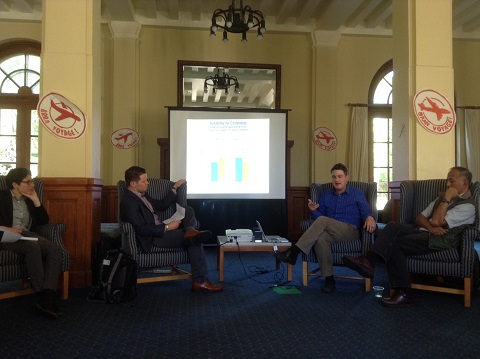
Report (English/Japanese):
At this interactive seminar, three panelists specializing in history and policy of immigration presented their views and analyses on the highly controversial issue, especially in the current presidential election year.
Reflecting their disciplines, their presentations and subsequent discussions tended to emphasize a close link between the immigration issue and racial problems within the context of US politics and policy choices, thus often resulting in rather short-term fluctuations in public interest and enthusiasm in this issue, as some panelist pointed out.
What is missing in this seminar as well as public discussion in the US seems to be the analysis and understanding of long-term cost and benefit of immigration, especially in economic terms, from the national and international viewpoint.
(Reported by T. Miyao)
報告:
このインタラクティブなセミナーで、移民の歴史や政策の専門家である3人のパネリストが、大統領選挙の年に特に論争が激しくなる移民問題についての意見や分析のプレセンを行った。
パネリストたちの専門分野を反映して、プレゼンもその後の討論も、米国の政治と政策について移民問題を人種問題に関連付ける傾向が明らかで、そのため米国民のこの問題に対する関心の高まりが短期間に上下する結果になることがパネリストによっても指摘された。
このセミナーでも一般の米国民の間の議論でも欠けがちなのは、移民が持つ長期的なベネフィットとコスト、特に国全体や世界全体の視点から経済面での効果の分析や理解ではないかと感じさせるものであった。
(宮尾)
--------------------------------------------------------------------------------
スタンフォード・オープンXチェンジ・セミナー「移民政策について学ぶ」(2016年5月12日)
Title タイトル: "Learning Together About Immigration Policies & Experiences"
Panelists パネリスト :
Shanto Iyengar, Chair in Communication, Professor of Political Science and Director of the Political Communication Laboratory
Ana Minian, Assistant Professor, Department of History and the Center for Comparative Studies in Race and Ethnicity (CCSRE)
Greg Walton, Associate Professor, Department of Psychology
Date/Time 日時: May 12(Th) 15:30-17:00
Venue 場所: Branner Hall Lounge, Stanford
Website ウェブサイト: https://events.stanford.edu/events/605/60599/
Sponsored by 主催: OpenXChange, CCSRE, El Centro Y Chicano, Immigrants' Rights Law Clinic, Stanford Humanities Center, SIG, Stanford Law School
Panel at the Seminar in Branner Hall Lounge: セミナーでのパネリストのプレゼン

Report (English/Japanese):
At this interactive seminar, three panelists specializing in history and policy of immigration presented their views and analyses on the highly controversial issue, especially in the current presidential election year.
Reflecting their disciplines, their presentations and subsequent discussions tended to emphasize a close link between the immigration issue and racial problems within the context of US politics and policy choices, thus often resulting in rather short-term fluctuations in public interest and enthusiasm in this issue, as some panelist pointed out.
What is missing in this seminar as well as public discussion in the US seems to be the analysis and understanding of long-term cost and benefit of immigration, especially in economic terms, from the national and international viewpoint.
(Reported by T. Miyao)
報告:
このインタラクティブなセミナーで、移民の歴史や政策の専門家である3人のパネリストが、大統領選挙の年に特に論争が激しくなる移民問題についての意見や分析のプレセンを行った。
パネリストたちの専門分野を反映して、プレゼンもその後の討論も、米国の政治と政策について移民問題を人種問題に関連付ける傾向が明らかで、そのため米国民のこの問題に対する関心の高まりが短期間に上下する結果になることがパネリストによっても指摘された。
このセミナーでも一般の米国民の間の議論でも欠けがちなのは、移民が持つ長期的なベネフィットとコスト、特に国全体や世界全体の視点から経済面での効果の分析や理解ではないかと感じさせるものであった。
(宮尾)
--------------------------------------------------------------------------------
Stanford Seminar on "Bitcoin and China": スタンフォード・セミナー「ビットコインと中国」 [Report]
Stanford Engineering Seminar: Bobby Lee "Bitcoin & China" (May 11, '16)
スタンフォード・エンジニアリング・セミナー:ボビー・リー「ビットコインと中国」(2016年5月12日)
Title タイトル: "Bitcoin, China, and Startups"
Speaker スピーカー: Bobby Lee, Co-founder and CEO of BTCC
Date/Time 日時: May 11(W), 2016, 4:30-6:00pm
Venue 場所: NVIDIA Auditorium, Huang Engineering Center, Stanford
Website ウェブサイト: https://events.stanford.edu/events/588/58835/
DFJ Entrepreneurial Thought Leaders Series
Sponsored by 主催: Stanford Technology Venture Program, Business Association of Stanford Entrepreneurial Students
Huang Engineering Center; Bobby Lee's presentation ボビー・リーのプレゼン
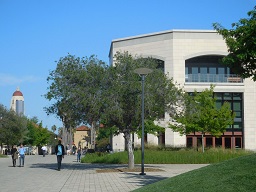
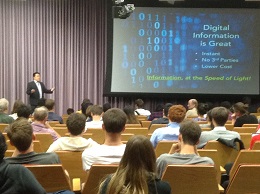
"Physical version" of bitcoin, Seminar shown on monitor outside the auditorium
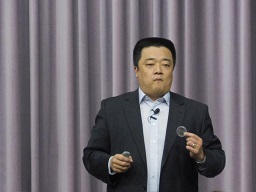
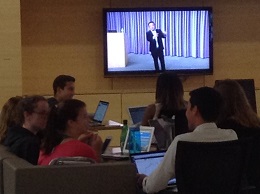
Report: (English/Japanese)
Mr. Bobby Lee with his BS and MS in Computer Science from Stanford is "co-founder and CEO of BTCC, the leading bitcoin financial platform and the longest-running bitcoin exchange worldwide," according to Stanford's event website.
His seminar at the Engineering Center Auditorium has revealed why he has been so successful in this highly controversial business in the tightly regulated country.
After explaining the basic concept and nature of bitcoin, including "bitcoin mining," which itself is an interesting process, he turned to why bitcoin is so popular in China and also how to make a good entrepreneur in China, rather than getting into technological details about bitcoin, such as "blockchain," which most of the audience was interested in.
Furthermore, in taking up the Chinese situation, he emphasized mostly positive aspects (saying "the Chinese like bitcoin because it represents the digital future" and "the Chinese government seems supportive of bitcoin") and minimized the widely believed negative aspects (saying "bitcoin is not so heavily used to evade capital controls in China").
So, this seminar turned out to be a kind of promotional pitch rather than an academic explanation about bitcoin and its acceptance in China.
In any case, he is a terrific salesperson, and it is now understandable why he has been so successful in China for so long.
(Reported by T. Miyao)
報告:
ボビー・リー氏は、スタンフォードのコンピューターサイエンスの学士号と修士号を持つ中国の起業家で、彼が共同創業者とCEOであるBTCC社は、主要なビットコイン金融プラットフォームであり、ビットコインの取り引きでは世界で最も長く続いている会社である(上記ウェブサイトによる)。
彼のエンジニアリングスクール・センターの講堂でのセミナーは、なぜ彼が規制の厳しい中国で問題が多いビットコイン・ビジネスを成功裏に進められているかを示すものであった。
まず、ビットコインの基本的な概念や性格が説明され、例えば「ビットコイン・マイニング(採掘)」といった面白い概念の説明もあったが、その後「ブロックチェイン」などの参加者が聞きたかったビットコインの技術的な詳細には触れずに、話を中国の状況に転じて、なぜビットコインが中国で人気があるか、またより一般的に中国での起業家のあり方などが議論された。
さらに中国の状況について、彼はもっぱらプラスの側面を強調し(「中国人がビットコインが好きなのは、それがデジタル社会の将来を表すものだから」、また「中国政府はビットコインに対して理解を示している」などと言って)、その一方で広く信じられているマイナスの側面をそれほど深刻ではないという(ビットコインは中国の資本規制を回避する方法としてはあまり使われていない」などと言って)擁護する姿勢を示した。
そのように彼のセミナーは、ビットコインと中国での受け入れについての学術的な説明ではなく、一種のプロモーション的な売り込みともいえるものであった。
いずれにしても、ボビー・リー氏が大変なセールスマンであることは確かで、それがなぜ彼が中国でこれだけ長く商売を続けることに成功しているかの理由と言えるであろう。
(宮尾)
--------------------------------------------------------------------------------------
スタンフォード・エンジニアリング・セミナー:ボビー・リー「ビットコインと中国」(2016年5月12日)
Title タイトル: "Bitcoin, China, and Startups"
Speaker スピーカー: Bobby Lee, Co-founder and CEO of BTCC
Date/Time 日時: May 11(W), 2016, 4:30-6:00pm
Venue 場所: NVIDIA Auditorium, Huang Engineering Center, Stanford
Website ウェブサイト: https://events.stanford.edu/events/588/58835/
DFJ Entrepreneurial Thought Leaders Series
Sponsored by 主催: Stanford Technology Venture Program, Business Association of Stanford Entrepreneurial Students
Huang Engineering Center; Bobby Lee's presentation ボビー・リーのプレゼン


"Physical version" of bitcoin, Seminar shown on monitor outside the auditorium


Report: (English/Japanese)
Mr. Bobby Lee with his BS and MS in Computer Science from Stanford is "co-founder and CEO of BTCC, the leading bitcoin financial platform and the longest-running bitcoin exchange worldwide," according to Stanford's event website.
His seminar at the Engineering Center Auditorium has revealed why he has been so successful in this highly controversial business in the tightly regulated country.
After explaining the basic concept and nature of bitcoin, including "bitcoin mining," which itself is an interesting process, he turned to why bitcoin is so popular in China and also how to make a good entrepreneur in China, rather than getting into technological details about bitcoin, such as "blockchain," which most of the audience was interested in.
Furthermore, in taking up the Chinese situation, he emphasized mostly positive aspects (saying "the Chinese like bitcoin because it represents the digital future" and "the Chinese government seems supportive of bitcoin") and minimized the widely believed negative aspects (saying "bitcoin is not so heavily used to evade capital controls in China").
So, this seminar turned out to be a kind of promotional pitch rather than an academic explanation about bitcoin and its acceptance in China.
In any case, he is a terrific salesperson, and it is now understandable why he has been so successful in China for so long.
(Reported by T. Miyao)
報告:
ボビー・リー氏は、スタンフォードのコンピューターサイエンスの学士号と修士号を持つ中国の起業家で、彼が共同創業者とCEOであるBTCC社は、主要なビットコイン金融プラットフォームであり、ビットコインの取り引きでは世界で最も長く続いている会社である(上記ウェブサイトによる)。
彼のエンジニアリングスクール・センターの講堂でのセミナーは、なぜ彼が規制の厳しい中国で問題が多いビットコイン・ビジネスを成功裏に進められているかを示すものであった。
まず、ビットコインの基本的な概念や性格が説明され、例えば「ビットコイン・マイニング(採掘)」といった面白い概念の説明もあったが、その後「ブロックチェイン」などの参加者が聞きたかったビットコインの技術的な詳細には触れずに、話を中国の状況に転じて、なぜビットコインが中国で人気があるか、またより一般的に中国での起業家のあり方などが議論された。
さらに中国の状況について、彼はもっぱらプラスの側面を強調し(「中国人がビットコインが好きなのは、それがデジタル社会の将来を表すものだから」、また「中国政府はビットコインに対して理解を示している」などと言って)、その一方で広く信じられているマイナスの側面をそれほど深刻ではないという(ビットコインは中国の資本規制を回避する方法としてはあまり使われていない」などと言って)擁護する姿勢を示した。
そのように彼のセミナーは、ビットコインと中国での受け入れについての学術的な説明ではなく、一種のプロモーション的な売り込みともいえるものであった。
いずれにしても、ボビー・リー氏が大変なセールスマンであることは確かで、それがなぜ彼が中国でこれだけ長く商売を続けることに成功しているかの理由と言えるであろう。
(宮尾)
--------------------------------------------------------------------------------------
Opportunity Conference 2016@CUHK: 香港中文大学でのコンファレンス2016 [Report]
Opportunity Conference 2016@CUHK: 香港中文大学でのコンファレンス2016
Date/Time: April 23 (Sat), 2016, 1:30-7:00pm: 日時:4月23日(土)13:30-19:00
Place: Cheng Yu Tung Building, CUHK: 場所:香港中文大学Cheng Yu Tungビル
Organizer: Business School at CUHK: 主催:香港中文大学ビジネススクール
Theme: HK: Hub of Innovation in Asia: テーマ:香港;アジアのイノベーション・ハブ
Opening Remarks: 14:00 - 14:10
Prof. Jeff YEUNG, Director, MSc, Info & Tech Mgmt, and Dept of DSME, CUHK
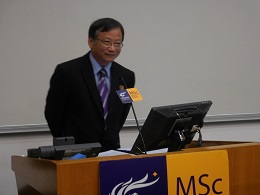
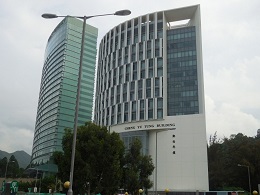
Session I: Innovation in Asia: 14:10 - 16:00
[Left] Prof. Kin Chung HO (Open Univ. of HK) “Creating an Innovation Space in HK”, [Right] Prof. Takahiro MIYAO (Tsukuba Univ. & USC) “New Opportunities for IT Innovation and Entrepreneurship” - Right Photo from Facebook
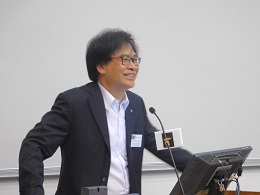
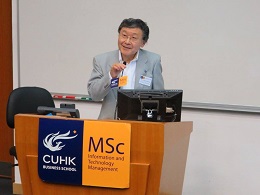
[Left] Ms. Elaine ANN (Kaizor Innovation) “What Can Bruce Lee Teach Us About Innovation for HK”, [Right] Panel Discussion: Moderator, Prof. Walter MOK (CUHK & Stanford Univ.) -- Right Photo from Facebook
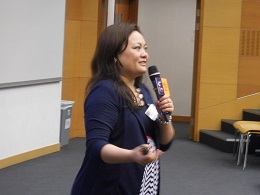
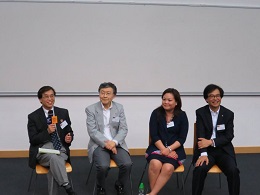
Session II: Keynote Address & TI Town Hall Meeting: 16:30-19:00
[Left] Ir Allen YEUNG (Gov. Chief Info Officer) “HK: Hub of IT Innovation in Asia”, [Right] Hon. Charles MOK, JP (HK, Legislative Councillor) “Creating a Bright Future for HK IT Industry”
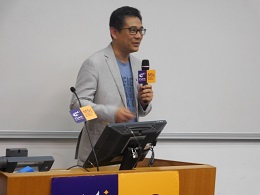
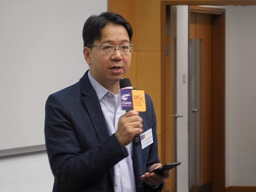
Town Hall Discussion: Moderator, Prof. Walter MOK (CUHK & Stanford Univ.)
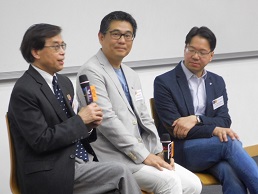
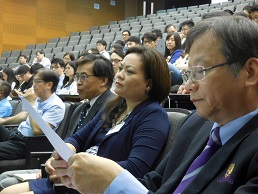
Conference Website: http://dsme.baf.cuhk.edu.hk/opportunity2016/
Conference Facebook: https://www.facebook.com/media/set/?set=a.697772213699163.1073741841.172393756237014&type=3
Report:
Hong Kong as Asia's innovation center a la Silicon Valley in the global economy -- that is what outsiders like me might as well expect of this economically vibrant city, which is often ranked number one in international competitiveness and IT infrastructure.
However, surprisingly, at least to me, almost all the speakers at this year's Opportunity Conference at CUHK addressed various problems and obstacles that young people in Hong Kong are facing in trying to start new business as entrepreneurs, much like what I hear about entrepreneurship, or lack of it, in Japan.
It looked like everyone in Hong Kong was doing "soul-searching" and asking what innovation should be of the people, by the people and for the people of Hong Kong, as surprisingly few new ideas and innovations are coming out of this technologically advanced city.
After all, it comes down to the obvious fact that it is not the existing technology or the current standard of living, but the "ecosystem" and "culture" of risk taking for active human interaction and open exchange of ideas to produce innovations and entrepreneurship, which tend to be lacking even among most advanced regions across East Asia, and Hong Kong is no exception.
Having said this, I strongly feel that many young people in Hong Kong seem to be taking a step forward to be true entrepreneurs through excellent entrepreneurship programs at HK's business schools like the one at CUHK. Hopefully, those small steps by individuals will eventually amount to a giant leap for Hong Kong to become a true innovation center in the global economy in the near future.
(Reported by Takahiro Miyao)
Reference: http://dsme.baf.cuhk.edu.hk/opportunity2016/images/ProfMiyao.pdf
------------------------------------------------------------------------------------------
報告:(Japanese)
世界経済におけるシリコンバレーのような役割を果たすアジアのイノベーションセンター香港 --- これが私のようなアウトサイダーが持つ香港のイメージであり、それはしばしば国際競争力やITインフラのレベルで世界一にランクされる経済的に繁栄するこの都市に期待するものでもある。
しかし驚いたことに、香港中文大学で開催された2016年度「オポチュニティ・コンファレンス」のスピーカーは誰しも香港の若者が新しいビジネスを起業することを阻む様々な問題や障害を強調していたのは、ちょうど日本での起業家精神の欠如の議論を彷彿させるものであった。
それは、この都市が技術的には先進経済であるにもかかわらず、あまり新しいアイデアやイノベーションが生まれない現実に直面し、あたかも香港の誰もが「自分探し」をして、香港の「人民の人民による人民のためのイノベーション」がどうあるべきかを問うているようにみえた。
結局のところ、すべては既存の技術や現在の生活の水準ではなく、リスクを避けずに人々が交流し、色々なアイデアを交換するような「エコシステム」や「文化」がイノベーションや起業家精神を生み出す上で重要で、それが東アジア地域では先進的な地域でさえも欠けていることが問題であり、香港も例外ではないといえる。
とはいえ、香港の若者たちは、香港中文大学のような地元の優秀な大学のビジネススクールの起業家養成プログラムを通じて真の起業家になるための第一歩を踏み出しており、そのような個人による小さな一歩前進が全体として、やがて近い将来香港にとって世界経済の真のイノベーションセンターに向かっての大きな飛躍に結びつくことを期待したいものである。
(文責:宮尾尊弘)
参考: http://dsme.baf.cuhk.edu.hk/opportunity2016/images/ProfMiyao.pdf
------------------------------------------------------------------------------------------
Date/Time: April 23 (Sat), 2016, 1:30-7:00pm: 日時:4月23日(土)13:30-19:00
Place: Cheng Yu Tung Building, CUHK: 場所:香港中文大学Cheng Yu Tungビル
Organizer: Business School at CUHK: 主催:香港中文大学ビジネススクール
Theme: HK: Hub of Innovation in Asia: テーマ:香港;アジアのイノベーション・ハブ
Opening Remarks: 14:00 - 14:10
Prof. Jeff YEUNG, Director, MSc, Info & Tech Mgmt, and Dept of DSME, CUHK


Session I: Innovation in Asia: 14:10 - 16:00
[Left] Prof. Kin Chung HO (Open Univ. of HK) “Creating an Innovation Space in HK”, [Right] Prof. Takahiro MIYAO (Tsukuba Univ. & USC) “New Opportunities for IT Innovation and Entrepreneurship” - Right Photo from Facebook


[Left] Ms. Elaine ANN (Kaizor Innovation) “What Can Bruce Lee Teach Us About Innovation for HK”, [Right] Panel Discussion: Moderator, Prof. Walter MOK (CUHK & Stanford Univ.) -- Right Photo from Facebook


Session II: Keynote Address & TI Town Hall Meeting: 16:30-19:00
[Left] Ir Allen YEUNG (Gov. Chief Info Officer) “HK: Hub of IT Innovation in Asia”, [Right] Hon. Charles MOK, JP (HK, Legislative Councillor) “Creating a Bright Future for HK IT Industry”


Town Hall Discussion: Moderator, Prof. Walter MOK (CUHK & Stanford Univ.)


Conference Website: http://dsme.baf.cuhk.edu.hk/opportunity2016/
Conference Facebook: https://www.facebook.com/media/set/?set=a.697772213699163.1073741841.172393756237014&type=3
Report:
Hong Kong as Asia's innovation center a la Silicon Valley in the global economy -- that is what outsiders like me might as well expect of this economically vibrant city, which is often ranked number one in international competitiveness and IT infrastructure.
However, surprisingly, at least to me, almost all the speakers at this year's Opportunity Conference at CUHK addressed various problems and obstacles that young people in Hong Kong are facing in trying to start new business as entrepreneurs, much like what I hear about entrepreneurship, or lack of it, in Japan.
It looked like everyone in Hong Kong was doing "soul-searching" and asking what innovation should be of the people, by the people and for the people of Hong Kong, as surprisingly few new ideas and innovations are coming out of this technologically advanced city.
After all, it comes down to the obvious fact that it is not the existing technology or the current standard of living, but the "ecosystem" and "culture" of risk taking for active human interaction and open exchange of ideas to produce innovations and entrepreneurship, which tend to be lacking even among most advanced regions across East Asia, and Hong Kong is no exception.
Having said this, I strongly feel that many young people in Hong Kong seem to be taking a step forward to be true entrepreneurs through excellent entrepreneurship programs at HK's business schools like the one at CUHK. Hopefully, those small steps by individuals will eventually amount to a giant leap for Hong Kong to become a true innovation center in the global economy in the near future.
(Reported by Takahiro Miyao)
Reference: http://dsme.baf.cuhk.edu.hk/opportunity2016/images/ProfMiyao.pdf
------------------------------------------------------------------------------------------
報告:(Japanese)
世界経済におけるシリコンバレーのような役割を果たすアジアのイノベーションセンター香港 --- これが私のようなアウトサイダーが持つ香港のイメージであり、それはしばしば国際競争力やITインフラのレベルで世界一にランクされる経済的に繁栄するこの都市に期待するものでもある。
しかし驚いたことに、香港中文大学で開催された2016年度「オポチュニティ・コンファレンス」のスピーカーは誰しも香港の若者が新しいビジネスを起業することを阻む様々な問題や障害を強調していたのは、ちょうど日本での起業家精神の欠如の議論を彷彿させるものであった。
それは、この都市が技術的には先進経済であるにもかかわらず、あまり新しいアイデアやイノベーションが生まれない現実に直面し、あたかも香港の誰もが「自分探し」をして、香港の「人民の人民による人民のためのイノベーション」がどうあるべきかを問うているようにみえた。
結局のところ、すべては既存の技術や現在の生活の水準ではなく、リスクを避けずに人々が交流し、色々なアイデアを交換するような「エコシステム」や「文化」がイノベーションや起業家精神を生み出す上で重要で、それが東アジア地域では先進的な地域でさえも欠けていることが問題であり、香港も例外ではないといえる。
とはいえ、香港の若者たちは、香港中文大学のような地元の優秀な大学のビジネススクールの起業家養成プログラムを通じて真の起業家になるための第一歩を踏み出しており、そのような個人による小さな一歩前進が全体として、やがて近い将来香港にとって世界経済の真のイノベーションセンターに向かっての大きな飛躍に結びつくことを期待したいものである。
(文責:宮尾尊弘)
参考: http://dsme.baf.cuhk.edu.hk/opportunity2016/images/ProfMiyao.pdf
------------------------------------------------------------------------------------------
Prof. Walter Mok's Class at CUHK in Hong Kong: 香港中文大学でのモク教授のクラス [Report]
Prof. Walter Mok's Class at CUHK in Hong Kong: 香港中文大学でのモク教授のクラス
Date/Time: April 20 (W), 2016, 6:45-9:45pm: 日時:4月20日(水)18:45-21:45
Place: Business School at CUHK: 場所:香港中文大学ビジネススクール
Lecturer: Prof. Walter Mok: 講師:ウォルター・モク教授
Class: "Startup - from Idea to Reality": クラス「スタートアップ:アイデアから現実へ」
Prof. Mok's Class in Cheng Yu Tung Bldg at the Chinese University of Hong Kong

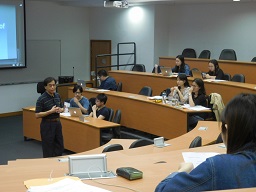
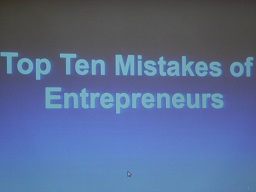
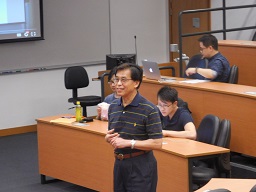
Report:
"In the West, especially in Silicon Valley, investors like venture capitalists often help startup entrepreneurs succeed as advisers or mentors, while investors in the East just sit and wait to be paid back successfully by the startup companies that they invest in," commented by Prof. Walter Mok, when he took up a statement "Don't befriend your VCs" in the video of Guy Kawasaki's lecture on "Top Ten Mistakes of Entrepreneurs" shown at the beginning of his class at CUHK.
That kind of useful suggestions and discussions took place in his very creative and interactive class "Startup - from Idea to Reality" attended by about 40 students, who seemed eager to be successful entrepreneurs themselves.
As Prof. Mok himself is an active scientist and entrepreneur, affiliated with Stanford University, he could give any kind of information and advise that those students need to start their own business in HK or elsewhere.
In fact, CUHK Business School seems quite eager to connect with Silicon Valley, as evidenced by a joint activity like the "EYE (Empowering Young Entrepreneurs) Program" between its Center for Entrepreneurship and Google to boost HK's startups:
http://entrepreneurship.bschool.cuhk.edu.hk/eyeprogram
For Dr. Walter Mok's background, see the following:
http://asia.stanford.edu/?page_id=2871
(Reported by Takahiro Miyao)
-----------------------------------------------------------------------------------------
Date/Time: April 20 (W), 2016, 6:45-9:45pm: 日時:4月20日(水)18:45-21:45
Place: Business School at CUHK: 場所:香港中文大学ビジネススクール
Lecturer: Prof. Walter Mok: 講師:ウォルター・モク教授
Class: "Startup - from Idea to Reality": クラス「スタートアップ:アイデアから現実へ」
Prof. Mok's Class in Cheng Yu Tung Bldg at the Chinese University of Hong Kong




Report:
"In the West, especially in Silicon Valley, investors like venture capitalists often help startup entrepreneurs succeed as advisers or mentors, while investors in the East just sit and wait to be paid back successfully by the startup companies that they invest in," commented by Prof. Walter Mok, when he took up a statement "Don't befriend your VCs" in the video of Guy Kawasaki's lecture on "Top Ten Mistakes of Entrepreneurs" shown at the beginning of his class at CUHK.
That kind of useful suggestions and discussions took place in his very creative and interactive class "Startup - from Idea to Reality" attended by about 40 students, who seemed eager to be successful entrepreneurs themselves.
As Prof. Mok himself is an active scientist and entrepreneur, affiliated with Stanford University, he could give any kind of information and advise that those students need to start their own business in HK or elsewhere.
In fact, CUHK Business School seems quite eager to connect with Silicon Valley, as evidenced by a joint activity like the "EYE (Empowering Young Entrepreneurs) Program" between its Center for Entrepreneurship and Google to boost HK's startups:
http://entrepreneurship.bschool.cuhk.edu.hk/eyeprogram
For Dr. Walter Mok's background, see the following:
http://asia.stanford.edu/?page_id=2871
(Reported by Takahiro Miyao)
-----------------------------------------------------------------------------------------
Stanford Colloquium: Japan’s Great Earthquake & Nuclear Disaster: 5 Years Later [Report]
Japan’s Great Earthquake & Nuclear Disaster: 5 Years Later (March 10, 2016)
Japan Program Colloquium Series@Stanford University:
“The Great Tohoku Earthquake & Tsunami and Fukushima Nuclear Disaster: 5 Years Later”
Date/Time: March 10(Th), 12:00-1:30pm
Venue: Philippines Conference Room, Encina Hall, Stanford
Moderator:
Phillip LIPSCY, Assistant Professor of Political Science, Freeman Spogli Institute Center Fellow, APARC, Stanford University
Panelists:
Daniel ALDRICH, Professor of Political Science, Public Policy and Urban Affairs, and Co-Director of the Masters Program in Security and Resilience, Northeastern University
Kenji KUSHIDA, Research Associate, Japan Program, APARC, Stanford University.
Kyoko SATO, Associate Director, The Program in Science, Technology, and Society, Stanford University
Webpage: http://aparc.fsi.stanford.edu/japan/events/great-tohoku-earthquake-tsunami-and-fukushima-nuclear-disaster-5-years-later
Photo:
(From left) Dr. Aldrich, Dr. Kushida, Dr. Sato and Dr. Lipscy
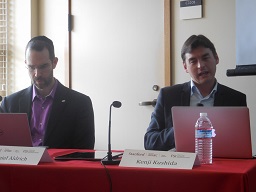
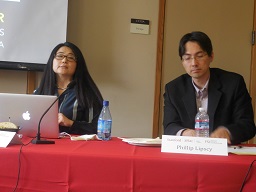
Report:
Commemorating the Great East Japan Earthquake, Tsunami and Nuclear accident on March 11, 2011, this timely colloquium presented three speakers with very different attitudes and approaches toward the unprecedented disaster in Japan.
First, Dr. Daniel Aldrich gave a summary of his comprehensive study on differences in casualty rates as well as social recovery rates among towns and villages in the affected regions, and drew an important conclusion, that is, human connections or social capital made a significant difference in most of the cases.
Second, Dr. Kenji Kushida made a visual presentation about what was really happening in and around the Fukushima Daiichi nuclear power plant during and after the accident for the purpose of filling in some information gaps about the nuclear disaster and spelling out some misinformation that is still circulated and widely believed among the public.
Finally, Dr. Kyoko Sato tried to answer the question of why the Japanese who went through the nightmare of Hiroshima and Nagasaki, came to embrace nuclear power as an important source of energy for the nation, however reluctantly, in the postwar period, and applied various social-political models for possible explanations.
Although all these presentations were very interesting and informative, there remained quite a few questions to be asked, such as whether it is appropriate to use "crime rates" to be a proxy for the degree of human connections in Dr. Aldrich's study, whether how "socially," if not academically, significant it is to revise the timeline of the nuclear accident in detail 5 years later, as Dr. Kushida did, and whether we can ignore, as Dr. Sato did, the fact that many Japanese, at least most political and business leaders, were really concerned about the heavy reliance of imported oil and its security and environmental consequences to find any meaningful answer to her question.
It is too bad that there was not much time left for discussions after the three presentations within an hour and a half. Hopefully, some more Q&As will take place at a seminar about nuclear safety to be held on March 11 as a sequel to this colloquium: http://aparc.fsi.stanford.edu/events/learning-disaster-nuclear-safety-and-security-five-years-after-fukushima
(Takahiro Miyao)
----------------------------------------------------------------------
Japan Program Colloquium Series@Stanford University:
“The Great Tohoku Earthquake & Tsunami and Fukushima Nuclear Disaster: 5 Years Later”
Date/Time: March 10(Th), 12:00-1:30pm
Venue: Philippines Conference Room, Encina Hall, Stanford
Moderator:
Phillip LIPSCY, Assistant Professor of Political Science, Freeman Spogli Institute Center Fellow, APARC, Stanford University
Panelists:
Daniel ALDRICH, Professor of Political Science, Public Policy and Urban Affairs, and Co-Director of the Masters Program in Security and Resilience, Northeastern University
Kenji KUSHIDA, Research Associate, Japan Program, APARC, Stanford University.
Kyoko SATO, Associate Director, The Program in Science, Technology, and Society, Stanford University
Webpage: http://aparc.fsi.stanford.edu/japan/events/great-tohoku-earthquake-tsunami-and-fukushima-nuclear-disaster-5-years-later
Photo:
(From left) Dr. Aldrich, Dr. Kushida, Dr. Sato and Dr. Lipscy


Report:
Commemorating the Great East Japan Earthquake, Tsunami and Nuclear accident on March 11, 2011, this timely colloquium presented three speakers with very different attitudes and approaches toward the unprecedented disaster in Japan.
First, Dr. Daniel Aldrich gave a summary of his comprehensive study on differences in casualty rates as well as social recovery rates among towns and villages in the affected regions, and drew an important conclusion, that is, human connections or social capital made a significant difference in most of the cases.
Second, Dr. Kenji Kushida made a visual presentation about what was really happening in and around the Fukushima Daiichi nuclear power plant during and after the accident for the purpose of filling in some information gaps about the nuclear disaster and spelling out some misinformation that is still circulated and widely believed among the public.
Finally, Dr. Kyoko Sato tried to answer the question of why the Japanese who went through the nightmare of Hiroshima and Nagasaki, came to embrace nuclear power as an important source of energy for the nation, however reluctantly, in the postwar period, and applied various social-political models for possible explanations.
Although all these presentations were very interesting and informative, there remained quite a few questions to be asked, such as whether it is appropriate to use "crime rates" to be a proxy for the degree of human connections in Dr. Aldrich's study, whether how "socially," if not academically, significant it is to revise the timeline of the nuclear accident in detail 5 years later, as Dr. Kushida did, and whether we can ignore, as Dr. Sato did, the fact that many Japanese, at least most political and business leaders, were really concerned about the heavy reliance of imported oil and its security and environmental consequences to find any meaningful answer to her question.
It is too bad that there was not much time left for discussions after the three presentations within an hour and a half. Hopefully, some more Q&As will take place at a seminar about nuclear safety to be held on March 11 as a sequel to this colloquium: http://aparc.fsi.stanford.edu/events/learning-disaster-nuclear-safety-and-security-five-years-after-fukushima
(Takahiro Miyao)
----------------------------------------------------------------------
Stanford Seminar: Yamaha Motor in Silicon Valley [Report]
Stanford Seminar: Yamaha Motor in Silicon Valley (March 8, 2016)
Silicon Valley-New Japan Project Public Forum Series
Title: Back to the Source: Yamaha Motor’s Challenges on Business Development
Speaker: Hiroshi "Hiro" Saijou, CEO and Managing Director, Yamaha Motor Ventures & Laboratory Silicon Valley Inc.
Date/Time: March 8(T), 2016, 4:15-6:00pm
Venue: Philippines Conference Room, Enc ina Hall, Stanford
Announcement: http://www.stanford-svnj.org/svnj-public-forum-march-8-2016
Report: by Takahiro Miyao
“I did not want to join Honda, which was number one in the motorcycle industry, and I did not like companies with their headquarters in Tokyo,” said Hiro Saijou, who explained why he chose Yamaha based in a small town to display his fighting spirit, which eventually led him to the current position in Silicon Valley.
In fact, he graduated from Kyushu University, where he apparently learned the spirit of “Kyushu Danji” (Kyushu guys), who brought down the Tokugawa feudal regime and established the new Meiji government in the late 19th century.
This analogy seems perfect, as Japan is now facing another “Kurofune” (Black Ship), not led by Commodore Perry, but by Silicon Valley disrupters, who are seriously challenging Japan’s traditional, if not feudal, way of doing business.
Saijou, who is one of the very few software engineers at Yamaha Motor and thus calls himself as an “alien,” says he always tries to challenge the traditional mindset of his bosses and fellow engineers in Japan, reminding them of the corporate founder’s pioneering philosophy: that is why Saijou chose the seminar title “Back to the Source.”
In his talk, he touched on so many ideas including his social and business objectives, his technological and management approaches, his current and potential projects, etc., which were not necessarily well-organized in presentation, or not even consistent with each other in content. But at the end of the day, a couple of things clearly came through:
First, he likes to do what he does best, that apparently is robotics. After all, he is a software engineer in that field. As a result, he prefers the idea of robots which drive motorcycles, rather than networked vehicles without human or robot drivers, claiming that robot drivers could be more widely and readily utilized than networked vehicles (although his approach would not necessarily serve his original purpose of solving the parking/congestion/accident problems).
Second, his company, Yamaha Motor Corp., seems to be making full use of the contribution of his presence in Silicon Valley and his projects, especially robotics, as a good business and PR strategy to compete with its rivals, Honda and Suzuki (see Nikkei Shimbun, featuring the Shizuoka economy, Feb. 21, 2016).
Finally, it appears that in his business pursuits Saijou is not at all afraid of or intimated by anything, whether it is his company’s president in Japan or it is Google in Silicon Valley. He has his enthusiasm and fighting spirit to challenge the “main stream,” just like a young samurai in Kyushu against the incumbent Shogun government in Edo. Whether he will survive and succeed in his endeavor to initiate a new business trend for the industry remains to be seen, however.
Hiro Saijou's Presentation and Q&A
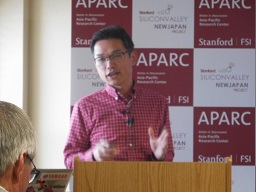
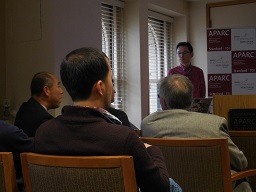
--------------------------------------------------------------------------------------
Silicon Valley-New Japan Project Public Forum Series
Title: Back to the Source: Yamaha Motor’s Challenges on Business Development
Speaker: Hiroshi "Hiro" Saijou, CEO and Managing Director, Yamaha Motor Ventures & Laboratory Silicon Valley Inc.
Date/Time: March 8(T), 2016, 4:15-6:00pm
Venue: Philippines Conference Room, Enc ina Hall, Stanford
Announcement: http://www.stanford-svnj.org/svnj-public-forum-march-8-2016
Report: by Takahiro Miyao
“I did not want to join Honda, which was number one in the motorcycle industry, and I did not like companies with their headquarters in Tokyo,” said Hiro Saijou, who explained why he chose Yamaha based in a small town to display his fighting spirit, which eventually led him to the current position in Silicon Valley.
In fact, he graduated from Kyushu University, where he apparently learned the spirit of “Kyushu Danji” (Kyushu guys), who brought down the Tokugawa feudal regime and established the new Meiji government in the late 19th century.
This analogy seems perfect, as Japan is now facing another “Kurofune” (Black Ship), not led by Commodore Perry, but by Silicon Valley disrupters, who are seriously challenging Japan’s traditional, if not feudal, way of doing business.
Saijou, who is one of the very few software engineers at Yamaha Motor and thus calls himself as an “alien,” says he always tries to challenge the traditional mindset of his bosses and fellow engineers in Japan, reminding them of the corporate founder’s pioneering philosophy: that is why Saijou chose the seminar title “Back to the Source.”
In his talk, he touched on so many ideas including his social and business objectives, his technological and management approaches, his current and potential projects, etc., which were not necessarily well-organized in presentation, or not even consistent with each other in content. But at the end of the day, a couple of things clearly came through:
First, he likes to do what he does best, that apparently is robotics. After all, he is a software engineer in that field. As a result, he prefers the idea of robots which drive motorcycles, rather than networked vehicles without human or robot drivers, claiming that robot drivers could be more widely and readily utilized than networked vehicles (although his approach would not necessarily serve his original purpose of solving the parking/congestion/accident problems).
Second, his company, Yamaha Motor Corp., seems to be making full use of the contribution of his presence in Silicon Valley and his projects, especially robotics, as a good business and PR strategy to compete with its rivals, Honda and Suzuki (see Nikkei Shimbun, featuring the Shizuoka economy, Feb. 21, 2016).
Finally, it appears that in his business pursuits Saijou is not at all afraid of or intimated by anything, whether it is his company’s president in Japan or it is Google in Silicon Valley. He has his enthusiasm and fighting spirit to challenge the “main stream,” just like a young samurai in Kyushu against the incumbent Shogun government in Edo. Whether he will survive and succeed in his endeavor to initiate a new business trend for the industry remains to be seen, however.
Hiro Saijou's Presentation and Q&A


--------------------------------------------------------------------------------------
ケベック州政府国際関係省での対話 Conversation at Quebec Gov’t Ministry of Int’l Relations (MRIF) [Report]
ケベック州政府国際関係省での対話(2015年8月31日)
Conversation at Quebec Gov’t Ministry of Int’l Relations (MRIF)
エティエンヌ・バイヤルジョン氏、モード・コテ女史、ドナルド・ルブラン氏
M. Etienne Baillargeon, Mme. Maude Cote, and M. Donald Leblanc
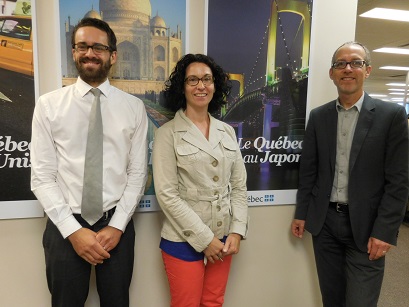
8月31日(月)に、ケベック市の州政府国際関係省(MRIF)の本部を訪れ、アジア・日本担当であるドナルド・ルブラン氏(アジア太平洋、ラテンアメリカ、カリブ諸国担当ディレクター)、モード・コテ女史(日本、韓国、オセアニア担当チーフ)とエティエンヌ・バイヤルジョン氏(日本、韓国、オセアニア担当官)の3名と会うことができた。
州政府の担当者と会見する目的は、日本とケベックにかかわる最近の文化活動についての意見や情報を交換することであった。
最初に驚いたのは、ケベックの担当官たちが日本のポップカルチャーやクールジャパンに対して持つ関心の強さで、その質問に答えて、まず私から日本政府がアニメ、マンガ、ゲーム、映画、ファッション、デザイン、さらには和食などのポピュラーカルチャーを支援してそれに関するグッズやサービスを海外に売り込むとともに、2016年の三重県伊勢志摩サミットや2020の東京オリンピックに向けて外国人の観光客を日本に呼び込もうという最近のクールジャパン戦略について説明した。
実際、ここでこのようなテーマについて議論するのはタイミング的にも場所的にもまさにベストで、ちょうど州政府の庁舎の近くにあるケベック州美術館(http://www.mnbaq.org/)で、日本に関する特別展示が行われていた。それは「ジャポニズム」の時代を取り上げた「Inspiration Japon」とケベックのアーティストによる日本の伝統を題材とするポップアート「Nippon-Fiction」というもので、私は国際関係省を訪れる前にこれらの展示を見て回って大いにエンジョイすることができた。
それから州政府担当者たちと、日本とケベックの間でどのようにアーティストやクリエーターの交流を促進することができるかを議論したが、すでにダンスパフォーマーについてはケベックから何人かが州政府の支援を得て日本に短期間滞在し交流を深めているが、逆に日本のアーティストやパフォーマーが日本政府の支援でケベックに滞在するプログラムはこれまでなかったのではないかという点が、州政府担当者から指摘された。それについては、アニメ、マンガ、ゲーム、映画、日本食料理などの分野で、現在日本政府が「クールジャパン戦略」の一環として考えているのではないかという期待も表明された。
さらに、日本とケベックのアーティストやクリエーターとスポンサーやビジネスの間を取り持って、情報交換やビジネス交流を促進するようなプラットフォームのウェブサイトを立ち上げる可能性などが議論されたが、重要な問題は、どうやって質的および法律的な要件をクリアーして、国境を越えた真の協力を促進することができるかということであった。暫定的な結論は、まず第一歩として、例えば日本とケベックの映画産業の協会などが相互の交流を促進するためのプラットフォームづくりに興味を示すべきで、そのような段階を踏んで、やがて長期的により包括的で横断的な形でアーティストやクリエーターと受け入れ機関やビジネス組織とを引き合わせるプラットフォームが生まれてくるであろうという展望が示された。
指摘されるべきは、以上のような議論がすべて予定通り1時間以内に行われたということで、それはケベック政府ないし国際関係省がいかに物事を効率的に処理しているかを示しているものと思われる。その間、3名の担当官は非常に友好的かつ生産的な態度で接してくれたことが印象的であった。そのような態度から日本の政府関係者も大いに学んでほしいものである。
参考:
日本でのケベック州首相の講演(2011年8月)
http://japanquebec.blog76.fc2.com/blog-entry-76.html
モンレアル・ケベック訪問(2007年8月)
http://japanquebec.blog76.fc2.com/blog-date-200709.html
------------------------------------------------------------------------------------------
Conversation at Quebec Gov’t Ministry of Int’l Relations (MRIF)
On Monday, August 31, I visited the Ministry of International Relations and Francophonie (MRIF) at the Headquarter Building in Quebec city, where I was greeted by three officials in charge of Asia and Japan, M. Donald Leblanc (Asia-Pacific, Latin America and Caribbean Director), Mme. Maude Cote (Chief of the Japan, Korea and Oceania Desk), and M. Etienne Baillargeon (Officer at the Japan, Korea and Oceania Desk).
The main purpose of my visit was to exchange opinions and information with the Quebec officials about recent cultural activities concerning both Japan and Quebec.
First, in response to the surprisingly strong interest in Japan’s pop culture and the “Cool Japan” concept on the part of the Quebec officials, I tried to outline the recent strategy of the Japanese government to promote and support Japan’s popular culture such as anime, manga, games, films, fashion, design, cuisine, etc. for the purpose of marketing pop culture-related goods and services abroad as well as attracting foreign tourists to Japan in connection with the 2016 Summit in Mie Prefecture and the 2020 Olympics in Tokyo.
The timing and location for our discussion on this subject matter seemed perfect, as the National Museum of Fine Arts of Quebec near the Parliament Building (http://www.mnbaq.org/) was featuring the special exhibitions about Japan, “Inspiration Japon” (Japonism) and “Nippon-Fiction” (a Quebec artist’s traditional Japanese-style pop culture), which I enjoyed viewing, prior to my meeting at the Ministry.
Then, we discussed possible ways to encourage the exchange of artists and creators between Japan and Quebec. As pointed out by the officials, a number of Quebec artists such as dance performers have visited Japan for a short stay supported by the Quebec government, but there has not been any such arrangement for Japanese artists to stay in Quebec supported by the Japanese government so far, and it might well be under consideration by the Japanese government in the context of the Cool Japan strategy, especially in some pop culture fields such as anime, manga, games, films, cuisine, etc.
Then our discussion led to a possibility of creating a kind of “matching site” as a platform to introduce artists and creators on one hand and sponsors and business people on the other to facilitate mutual exchange of information and possibly business interaction between Japan and Quebec. However, the important question about this idea is how to meet the “quality” and “legal” requirements for real collaboration between them across national boundaries. Our tentative conclusion was that as a first step professional organizations such as film industries in Japan and Quebec could be interested in creating a platform for more active interactions between Japanese and Quebec film industries. As a result of this kind of step-by-step approach, a more comprehensive, across-the-board matching platform for artists/creators and hosting/business organizations might emerge in the long run.
All this discussion took place within an hour as planned, which implies how efficient the Quebec government, or at least the MRIF, operates, and I truly enjoyed talking with those three officials in such a friendly and productive manner, hoping that Japanese government officials could learn from them in this respect.
References:
Quebec Premier’s speech in Japan (August, 2011):
http://japanquebec.blog76.fc2.com/blog-entry-76.html
My visit to Montreal and Quebec city (August, 2007):
http://japanquebec.blog76.fc2.com/blog-date-200709.html
------------------------------------------------------------------------------------------
Conversation at Quebec Gov’t Ministry of Int’l Relations (MRIF)
エティエンヌ・バイヤルジョン氏、モード・コテ女史、ドナルド・ルブラン氏
M. Etienne Baillargeon, Mme. Maude Cote, and M. Donald Leblanc

8月31日(月)に、ケベック市の州政府国際関係省(MRIF)の本部を訪れ、アジア・日本担当であるドナルド・ルブラン氏(アジア太平洋、ラテンアメリカ、カリブ諸国担当ディレクター)、モード・コテ女史(日本、韓国、オセアニア担当チーフ)とエティエンヌ・バイヤルジョン氏(日本、韓国、オセアニア担当官)の3名と会うことができた。
州政府の担当者と会見する目的は、日本とケベックにかかわる最近の文化活動についての意見や情報を交換することであった。
最初に驚いたのは、ケベックの担当官たちが日本のポップカルチャーやクールジャパンに対して持つ関心の強さで、その質問に答えて、まず私から日本政府がアニメ、マンガ、ゲーム、映画、ファッション、デザイン、さらには和食などのポピュラーカルチャーを支援してそれに関するグッズやサービスを海外に売り込むとともに、2016年の三重県伊勢志摩サミットや2020の東京オリンピックに向けて外国人の観光客を日本に呼び込もうという最近のクールジャパン戦略について説明した。
実際、ここでこのようなテーマについて議論するのはタイミング的にも場所的にもまさにベストで、ちょうど州政府の庁舎の近くにあるケベック州美術館(http://www.mnbaq.org/)で、日本に関する特別展示が行われていた。それは「ジャポニズム」の時代を取り上げた「Inspiration Japon」とケベックのアーティストによる日本の伝統を題材とするポップアート「Nippon-Fiction」というもので、私は国際関係省を訪れる前にこれらの展示を見て回って大いにエンジョイすることができた。
それから州政府担当者たちと、日本とケベックの間でどのようにアーティストやクリエーターの交流を促進することができるかを議論したが、すでにダンスパフォーマーについてはケベックから何人かが州政府の支援を得て日本に短期間滞在し交流を深めているが、逆に日本のアーティストやパフォーマーが日本政府の支援でケベックに滞在するプログラムはこれまでなかったのではないかという点が、州政府担当者から指摘された。それについては、アニメ、マンガ、ゲーム、映画、日本食料理などの分野で、現在日本政府が「クールジャパン戦略」の一環として考えているのではないかという期待も表明された。
さらに、日本とケベックのアーティストやクリエーターとスポンサーやビジネスの間を取り持って、情報交換やビジネス交流を促進するようなプラットフォームのウェブサイトを立ち上げる可能性などが議論されたが、重要な問題は、どうやって質的および法律的な要件をクリアーして、国境を越えた真の協力を促進することができるかということであった。暫定的な結論は、まず第一歩として、例えば日本とケベックの映画産業の協会などが相互の交流を促進するためのプラットフォームづくりに興味を示すべきで、そのような段階を踏んで、やがて長期的により包括的で横断的な形でアーティストやクリエーターと受け入れ機関やビジネス組織とを引き合わせるプラットフォームが生まれてくるであろうという展望が示された。
指摘されるべきは、以上のような議論がすべて予定通り1時間以内に行われたということで、それはケベック政府ないし国際関係省がいかに物事を効率的に処理しているかを示しているものと思われる。その間、3名の担当官は非常に友好的かつ生産的な態度で接してくれたことが印象的であった。そのような態度から日本の政府関係者も大いに学んでほしいものである。
参考:
日本でのケベック州首相の講演(2011年8月)
http://japanquebec.blog76.fc2.com/blog-entry-76.html
モンレアル・ケベック訪問(2007年8月)
http://japanquebec.blog76.fc2.com/blog-date-200709.html
------------------------------------------------------------------------------------------
Conversation at Quebec Gov’t Ministry of Int’l Relations (MRIF)
On Monday, August 31, I visited the Ministry of International Relations and Francophonie (MRIF) at the Headquarter Building in Quebec city, where I was greeted by three officials in charge of Asia and Japan, M. Donald Leblanc (Asia-Pacific, Latin America and Caribbean Director), Mme. Maude Cote (Chief of the Japan, Korea and Oceania Desk), and M. Etienne Baillargeon (Officer at the Japan, Korea and Oceania Desk).
The main purpose of my visit was to exchange opinions and information with the Quebec officials about recent cultural activities concerning both Japan and Quebec.
First, in response to the surprisingly strong interest in Japan’s pop culture and the “Cool Japan” concept on the part of the Quebec officials, I tried to outline the recent strategy of the Japanese government to promote and support Japan’s popular culture such as anime, manga, games, films, fashion, design, cuisine, etc. for the purpose of marketing pop culture-related goods and services abroad as well as attracting foreign tourists to Japan in connection with the 2016 Summit in Mie Prefecture and the 2020 Olympics in Tokyo.
The timing and location for our discussion on this subject matter seemed perfect, as the National Museum of Fine Arts of Quebec near the Parliament Building (http://www.mnbaq.org/) was featuring the special exhibitions about Japan, “Inspiration Japon” (Japonism) and “Nippon-Fiction” (a Quebec artist’s traditional Japanese-style pop culture), which I enjoyed viewing, prior to my meeting at the Ministry.
Then, we discussed possible ways to encourage the exchange of artists and creators between Japan and Quebec. As pointed out by the officials, a number of Quebec artists such as dance performers have visited Japan for a short stay supported by the Quebec government, but there has not been any such arrangement for Japanese artists to stay in Quebec supported by the Japanese government so far, and it might well be under consideration by the Japanese government in the context of the Cool Japan strategy, especially in some pop culture fields such as anime, manga, games, films, cuisine, etc.
Then our discussion led to a possibility of creating a kind of “matching site” as a platform to introduce artists and creators on one hand and sponsors and business people on the other to facilitate mutual exchange of information and possibly business interaction between Japan and Quebec. However, the important question about this idea is how to meet the “quality” and “legal” requirements for real collaboration between them across national boundaries. Our tentative conclusion was that as a first step professional organizations such as film industries in Japan and Quebec could be interested in creating a platform for more active interactions between Japanese and Quebec film industries. As a result of this kind of step-by-step approach, a more comprehensive, across-the-board matching platform for artists/creators and hosting/business organizations might emerge in the long run.
All this discussion took place within an hour as planned, which implies how efficient the Quebec government, or at least the MRIF, operates, and I truly enjoyed talking with those three officials in such a friendly and productive manner, hoping that Japanese government officials could learn from them in this respect.
References:
Quebec Premier’s speech in Japan (August, 2011):
http://japanquebec.blog76.fc2.com/blog-entry-76.html
My visit to Montreal and Quebec city (August, 2007):
http://japanquebec.blog76.fc2.com/blog-date-200709.html
------------------------------------------------------------------------------------------
宮尾尊弘「秋の経済教育」(報告とビデオ) [Report]
宮尾尊弘「秋の経済教育ー授業に役立つ経済学」
日時:2014年11月15日 16:00~17:30
場所:日本大学経済学部7号館7041号(東京都千代田区三崎町)
主催:経済教育ネットワーク、共催:日本取引所ブループ(東京証券取引所)
講師:宮尾尊弘(筑波大学名誉教授)
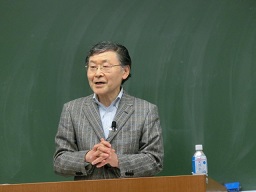
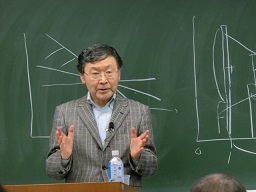
ビデオ(講演の最初22分間):http://youtu.be/d7rY-UCJ-Oo
参考「シンプル経済教室」:https://sites.google.com/site/econeduvideo/
概要(配布資料の内容):
1.経済の基本問題である「需要と供給」、「効率と公平」、「公共と協力」の主要なポイントをおさらいした後に、どうしたら経済問題の本質を分かりやすく手短に生徒に伝えられるかについて解説。
1-1: 「需要」と「供給」はオークションの例を使って具体的に見られるようにする。
1-2: 「効率」と「公平」の望ましい組み合わせは人によって違うことを具体的に示す。
1-3: 「公共」と「協力」は社会で自発的に達成が難しいことを実感させる
2.「シンプル経済教室」のようなビデオ教材の作り方、ウェブへの掲載方法、そしてクラスでの利用の仕方などを説明。
2-1: ビデオ教材はデジカメでもビデオカメラでも自分だけで簡単に作成できる。
2-2: ウェブへの掲載はYouTubeを使ってアップし、Google Sitesでページを作る。
2-3: クラスでの使い方は、予習用と授業中の利用の両方をうまく組み合わせる。
3.経済のような中高生が興味を持ちにくい科目をどう教えたら、生徒たちが自主的に学ぼうとする意欲を持つのかのヒントを提供。
3-1: 経済に関するストーリーをビジュアル化して伝え、特にビデオ教材などを活用する。
3-2: 知識水準ではなく、知識獲得の過程と学ぶ努力と進歩が重要であることを実感させる。
3-3: ビデオ教材による予習とクラスでの対話と評価を行い、学ぶ習慣の獲得を促進する。
アンケート結果(30名回答):
問1.ここで、経済の基本を学び確認できて、分かりやすく教えるヒントが得られましたか?
十分得られた(13人)、多少得られた(14人)、どちらとも言えない(3人)、
あまり得られなかった(3人)、 ほとんど得られなかった(0人)
問2.ここで、ビデオ教材の作成やウェブ掲載やクラスでの使い方について学べましたか?
十分学べた(12人)、多少学べた(14人)、どちらとも言えない(4人)、
あまり学べなかった(4人)、ほとんど学べなかった(0人)
問3.どんな生徒でもやる気を起こさせるような教え方のヒントが得られましたか?
十分得られた(11人)、多少得られた(13人)、どちらとも言えない(4人)、
あまり得られなかった(1人)、ほとんど得られなかった(0人)、無回答1人
報告:
質疑応答も含めて1時間半の短い講演でカバーできることは限られていたが、それでも経済を教える上で重要な3つの項目の解説と問題提起を行い、それなりの反応を得ることができた。
実際に、アンケートの結果でも、3つの項目すべてについて「多少は分かった」という答えが多く、それぞれ正味20分程度の講演から少しでも役に立てる情報やヒントを得てもらえたとすれば、とりあえず所期の目的を果したといえるであろう。
最初の項目である経済の基本については、レモンを絞る話が注目されて、特に中学の先生方から、中学生により分かりやすい例がないかどうか考えたいという積極的な意見も出された。
2つ目の項目であるビデオ教材については、自分でチャレンジしてみたい、また工夫して予習中心の教え方に取り組みたいという前向きの反応があった一方で、やはり技術的、時間的、環境的な制約などで特に中学レベルでは実現が難しいという答えもあり、課題の多さを感じさせるものであった。
3番目の項目である自主的に学ばせる工夫については、多くの参加者からストーリーとビジュアル化の重要性、また「リーダー・マネージャー・コーチ」の3つの教師の役割ついて賛同の意見があったが、生徒の評価について、また特にやる気のない生徒の扱いについて、「どうにもならない難しさが現実に存在する」という強い意見も出され、この問題の深刻さが浮き彫りになった。
いずれにしても、今回ざっと多くの項目をカバーして、経済を教える上でどこに問題があるのかについてヒントが得られただけでも大きな収穫であった。今後は、それぞれ示唆された課題に応えるように努力し、誰にでも役立つように「経済教室シリーズ」の改善と充実を図っていきたい。
(宮尾尊弘)
----------------------------------------------------------------------------------------
日時:2014年11月15日 16:00~17:30
場所:日本大学経済学部7号館7041号(東京都千代田区三崎町)
主催:経済教育ネットワーク、共催:日本取引所ブループ(東京証券取引所)
講師:宮尾尊弘(筑波大学名誉教授)


ビデオ(講演の最初22分間):http://youtu.be/d7rY-UCJ-Oo
参考「シンプル経済教室」:https://sites.google.com/site/econeduvideo/
概要(配布資料の内容):
1.経済の基本問題である「需要と供給」、「効率と公平」、「公共と協力」の主要なポイントをおさらいした後に、どうしたら経済問題の本質を分かりやすく手短に生徒に伝えられるかについて解説。
1-1: 「需要」と「供給」はオークションの例を使って具体的に見られるようにする。
1-2: 「効率」と「公平」の望ましい組み合わせは人によって違うことを具体的に示す。
1-3: 「公共」と「協力」は社会で自発的に達成が難しいことを実感させる
2.「シンプル経済教室」のようなビデオ教材の作り方、ウェブへの掲載方法、そしてクラスでの利用の仕方などを説明。
2-1: ビデオ教材はデジカメでもビデオカメラでも自分だけで簡単に作成できる。
2-2: ウェブへの掲載はYouTubeを使ってアップし、Google Sitesでページを作る。
2-3: クラスでの使い方は、予習用と授業中の利用の両方をうまく組み合わせる。
3.経済のような中高生が興味を持ちにくい科目をどう教えたら、生徒たちが自主的に学ぼうとする意欲を持つのかのヒントを提供。
3-1: 経済に関するストーリーをビジュアル化して伝え、特にビデオ教材などを活用する。
3-2: 知識水準ではなく、知識獲得の過程と学ぶ努力と進歩が重要であることを実感させる。
3-3: ビデオ教材による予習とクラスでの対話と評価を行い、学ぶ習慣の獲得を促進する。
アンケート結果(30名回答):
問1.ここで、経済の基本を学び確認できて、分かりやすく教えるヒントが得られましたか?
十分得られた(13人)、多少得られた(14人)、どちらとも言えない(3人)、
あまり得られなかった(3人)、 ほとんど得られなかった(0人)
問2.ここで、ビデオ教材の作成やウェブ掲載やクラスでの使い方について学べましたか?
十分学べた(12人)、多少学べた(14人)、どちらとも言えない(4人)、
あまり学べなかった(4人)、ほとんど学べなかった(0人)
問3.どんな生徒でもやる気を起こさせるような教え方のヒントが得られましたか?
十分得られた(11人)、多少得られた(13人)、どちらとも言えない(4人)、
あまり得られなかった(1人)、ほとんど得られなかった(0人)、無回答1人
報告:
質疑応答も含めて1時間半の短い講演でカバーできることは限られていたが、それでも経済を教える上で重要な3つの項目の解説と問題提起を行い、それなりの反応を得ることができた。
実際に、アンケートの結果でも、3つの項目すべてについて「多少は分かった」という答えが多く、それぞれ正味20分程度の講演から少しでも役に立てる情報やヒントを得てもらえたとすれば、とりあえず所期の目的を果したといえるであろう。
最初の項目である経済の基本については、レモンを絞る話が注目されて、特に中学の先生方から、中学生により分かりやすい例がないかどうか考えたいという積極的な意見も出された。
2つ目の項目であるビデオ教材については、自分でチャレンジしてみたい、また工夫して予習中心の教え方に取り組みたいという前向きの反応があった一方で、やはり技術的、時間的、環境的な制約などで特に中学レベルでは実現が難しいという答えもあり、課題の多さを感じさせるものであった。
3番目の項目である自主的に学ばせる工夫については、多くの参加者からストーリーとビジュアル化の重要性、また「リーダー・マネージャー・コーチ」の3つの教師の役割ついて賛同の意見があったが、生徒の評価について、また特にやる気のない生徒の扱いについて、「どうにもならない難しさが現実に存在する」という強い意見も出され、この問題の深刻さが浮き彫りになった。
いずれにしても、今回ざっと多くの項目をカバーして、経済を教える上でどこに問題があるのかについてヒントが得られただけでも大きな収穫であった。今後は、それぞれ示唆された課題に応えるように努力し、誰にでも役立つように「経済教室シリーズ」の改善と充実を図っていきたい。
(宮尾尊弘)
----------------------------------------------------------------------------------------
Workshop on Great Tohoku Earthquake@USC (6/28/2014) [Report]
Workshop on Great Tohoku Earthquake@USC (6/28/2014)
"Economic Effects of Great Tohoku Earthquake":「東北大震災の経済的影響」
Date/Time: June 28, 2014, 1-6pm: 2014年6月28日 13:00-18:00
Place: USC Davidson Conference Center: USCデビッドソン・コンファレンス・センター
Program: http://dornsife.usc.edu/conferences/tohoku-earthquake-conference-2014/program/
Report (see the Japanese version posted below the photos):
At this workshop, three interesting papers on the effects of the Great East-Japan Earthquake were presented. The first two were the econometric analysis of the negative effects of regional net output and supply shocks in the Tohoku and other regions in Japan, whereas the third one was about the financial impacts of the negative effects on main banks of the Great Earthquake in the Tohoku region.
Each of these three studies faced the problems of data and analytical limitations, but were successful in obtaining some meaningful results, at least as a first step.
At the same time, many hints on how to proceed from here to more comprehensive studies on the subject matter were obtained during the discussions and Q&A sessions. For example, more disaggregated, at least prefectural-level, data should be used to distinguish between the regions directly affected by the Great Earthquake and the other regions to obtain more relevant results, especially for policy purposes.
More hints and suggestions along those lines were explored in the final panel discussion session, although some time was devoted to related issues such as Abenomics and nuclear plant safety.
Takahiro Miyao (USC)
PS: For Abenomics, see the USC Conference organized by Prof. Robert Dekle:
http://miyao-blog.blog.so-net.ne.jp/2014-04-21
Session I (1pm - ):セッション I(13:00 - )
Chair: Tsutomu Miyagawa (Gakushuin University): 宮川努(学習院大学)
Speaker: Robert Dekle (USC) : ロバート・ディークル(南カリフォルニア大学)
"The Regional Spillover Effects of the Tohoku Earthquake"
「東北大震災のスピルオーバー効果」
Chair Prof. T. Miyagawa (middle) and Speaker Prof. R. Dekle
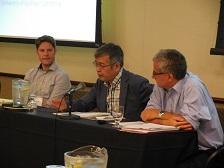
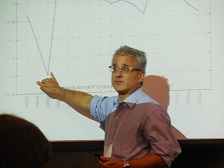
Co-author W. Xien, Discussant Prof. W. Hanlon & Prof. Dekle's response

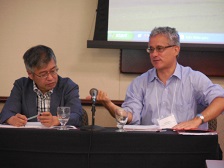
Session II (2pm - ):セッション II(14:00 - )
Chair: Kaoru Hosono (Gakushuin University): 細野薫(学習院大学)
Speaker: Joki Tokui (Shinshu University) : 徳井丞次(信州大学)
"The Economic Impact and Recovery of the Supply Chain Disruptions in the Great East-Japan Earthquake"
「東日本大震災によるサプライチェーン寸断の経済的効果と復興分析」
Speaker Prof. J. Tokui and Discussant Prof. Douglas Joines (USC)
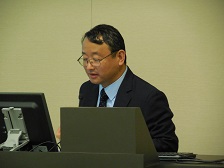
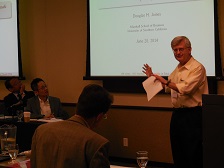
Session III (3:30pm - ):セッション III(15:30 - )
Chair: Najimadin Meshkati (USC): ナジマディン・メシュカティ(南カリフォルニア大学)
Speaker: Daisuke Miyakawa (Nihon University): 宮川大輔(日本大学)
"Financial Shocks and Natural Selection"
「金融ショックと自然淘汰」
Chair Prof. N. Meshkati and Speaker Prof. D. Miyakawa
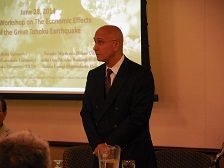
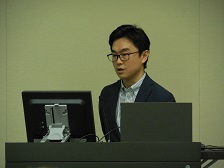
Discussant Prof. Yasushi Hamao (USC) and Q&A with participants
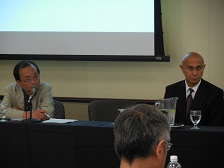
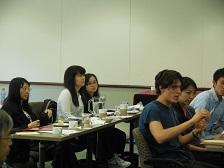
Panel Discussion (4:30pm - ):パネルディスカッション(16:30 - )
Economic Effects of the Great Tohoku Earthquake & Concluding Remarks
Chair: Robert Dekle: ロバート・ディークル
Panelists: Kaoru Hosono, Najimadin Meshkati & Tsutomu Miyagawa
パネリスト:細野薫、ナジマディン・メシュカティ、宮川努
Chair Prof. R. Dekle and Prof. K. Hosono's presentation
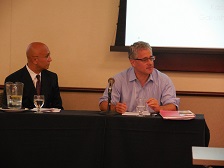
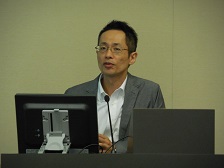
Presentations by Prof. N. Meshkati and Prof. T. Miyagawa
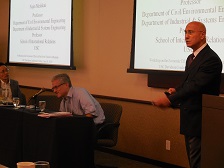
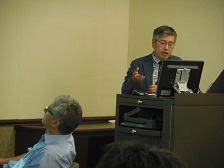
Report in Japanese: レポート(日本語版)
このワークショップでは、東日本大震災の経済的影響について3つの興味深い論文が発表された。最初の2つは、東北地方と他の地域の純生産や供給の負のショックの経済効果に関する計量分析で、3つ目の論文は東北地方で大震災の影響を受けたメインバンクが与えた金融面でのインパクトに関するものであった。
このいずれの論文もデータや分析の上での制約を抱えながら、それなりに意味のある結論を導いており、第一歩として評価に値するものであった。
同時に、ディスカッションやQ&Aのセッションで、この後どのように分析を改善していくべきかのヒントも多く得られたと思われる。例えば、直接の被災地域と他の地域を区別するためには、少なくとも県レベルのデータを使うべきで、特に政策的な意味を導く上ではそれが必要といった点などである。
最後のパネルディスカッションでは、このような問題がさらに掘り下げられたが、多少関連するテーマのアベノミクスや原発の安全性などにも時間が割かれた。
宮尾尊弘(USC)
追伸:アベノミクスについては、ロバート・ディークル教授がオーガナイズしたUSCでのコンファレンスを参照:
http://miyao-blog.blog.so-net.ne.jp/2014-04-21
--------------------------------------------------------------------------------------
"Economic Effects of Great Tohoku Earthquake":「東北大震災の経済的影響」
Date/Time: June 28, 2014, 1-6pm: 2014年6月28日 13:00-18:00
Place: USC Davidson Conference Center: USCデビッドソン・コンファレンス・センター
Program: http://dornsife.usc.edu/conferences/tohoku-earthquake-conference-2014/program/
Report (see the Japanese version posted below the photos):
At this workshop, three interesting papers on the effects of the Great East-Japan Earthquake were presented. The first two were the econometric analysis of the negative effects of regional net output and supply shocks in the Tohoku and other regions in Japan, whereas the third one was about the financial impacts of the negative effects on main banks of the Great Earthquake in the Tohoku region.
Each of these three studies faced the problems of data and analytical limitations, but were successful in obtaining some meaningful results, at least as a first step.
At the same time, many hints on how to proceed from here to more comprehensive studies on the subject matter were obtained during the discussions and Q&A sessions. For example, more disaggregated, at least prefectural-level, data should be used to distinguish between the regions directly affected by the Great Earthquake and the other regions to obtain more relevant results, especially for policy purposes.
More hints and suggestions along those lines were explored in the final panel discussion session, although some time was devoted to related issues such as Abenomics and nuclear plant safety.
Takahiro Miyao (USC)
PS: For Abenomics, see the USC Conference organized by Prof. Robert Dekle:
http://miyao-blog.blog.so-net.ne.jp/2014-04-21
Session I (1pm - ):セッション I(13:00 - )
Chair: Tsutomu Miyagawa (Gakushuin University): 宮川努(学習院大学)
Speaker: Robert Dekle (USC) : ロバート・ディークル(南カリフォルニア大学)
"The Regional Spillover Effects of the Tohoku Earthquake"
「東北大震災のスピルオーバー効果」
Chair Prof. T. Miyagawa (middle) and Speaker Prof. R. Dekle


Co-author W. Xien, Discussant Prof. W. Hanlon & Prof. Dekle's response


Session II (2pm - ):セッション II(14:00 - )
Chair: Kaoru Hosono (Gakushuin University): 細野薫(学習院大学)
Speaker: Joki Tokui (Shinshu University) : 徳井丞次(信州大学)
"The Economic Impact and Recovery of the Supply Chain Disruptions in the Great East-Japan Earthquake"
「東日本大震災によるサプライチェーン寸断の経済的効果と復興分析」
Speaker Prof. J. Tokui and Discussant Prof. Douglas Joines (USC)


Session III (3:30pm - ):セッション III(15:30 - )
Chair: Najimadin Meshkati (USC): ナジマディン・メシュカティ(南カリフォルニア大学)
Speaker: Daisuke Miyakawa (Nihon University): 宮川大輔(日本大学)
"Financial Shocks and Natural Selection"
「金融ショックと自然淘汰」
Chair Prof. N. Meshkati and Speaker Prof. D. Miyakawa


Discussant Prof. Yasushi Hamao (USC) and Q&A with participants


Panel Discussion (4:30pm - ):パネルディスカッション(16:30 - )
Economic Effects of the Great Tohoku Earthquake & Concluding Remarks
Chair: Robert Dekle: ロバート・ディークル
Panelists: Kaoru Hosono, Najimadin Meshkati & Tsutomu Miyagawa
パネリスト:細野薫、ナジマディン・メシュカティ、宮川努
Chair Prof. R. Dekle and Prof. K. Hosono's presentation


Presentations by Prof. N. Meshkati and Prof. T. Miyagawa


Report in Japanese: レポート(日本語版)
このワークショップでは、東日本大震災の経済的影響について3つの興味深い論文が発表された。最初の2つは、東北地方と他の地域の純生産や供給の負のショックの経済効果に関する計量分析で、3つ目の論文は東北地方で大震災の影響を受けたメインバンクが与えた金融面でのインパクトに関するものであった。
このいずれの論文もデータや分析の上での制約を抱えながら、それなりに意味のある結論を導いており、第一歩として評価に値するものであった。
同時に、ディスカッションやQ&Aのセッションで、この後どのように分析を改善していくべきかのヒントも多く得られたと思われる。例えば、直接の被災地域と他の地域を区別するためには、少なくとも県レベルのデータを使うべきで、特に政策的な意味を導く上ではそれが必要といった点などである。
最後のパネルディスカッションでは、このような問題がさらに掘り下げられたが、多少関連するテーマのアベノミクスや原発の安全性などにも時間が割かれた。
宮尾尊弘(USC)
追伸:アベノミクスについては、ロバート・ディークル教授がオーガナイズしたUSCでのコンファレンスを参照:
http://miyao-blog.blog.so-net.ne.jp/2014-04-21
--------------------------------------------------------------------------------------



